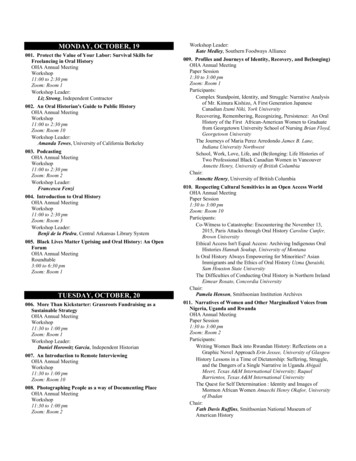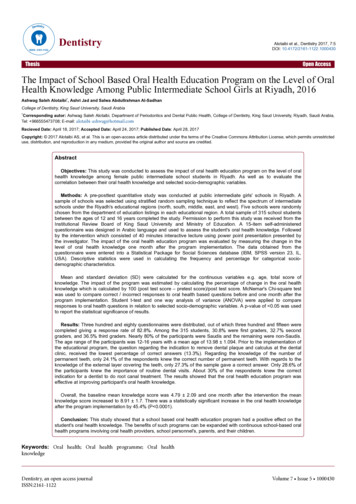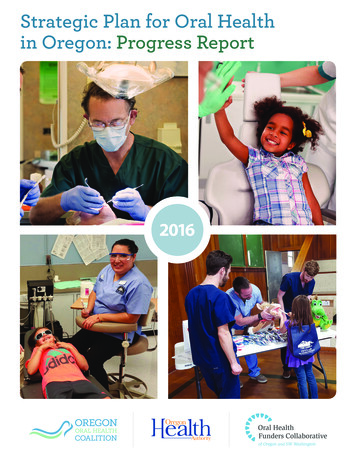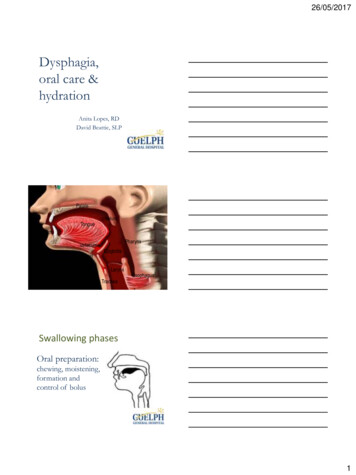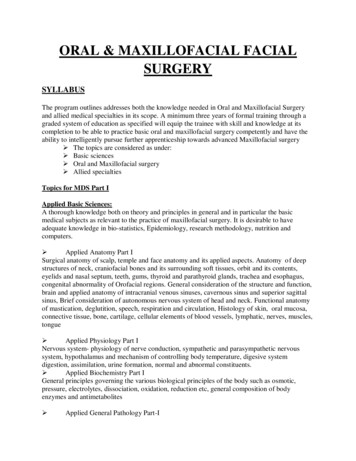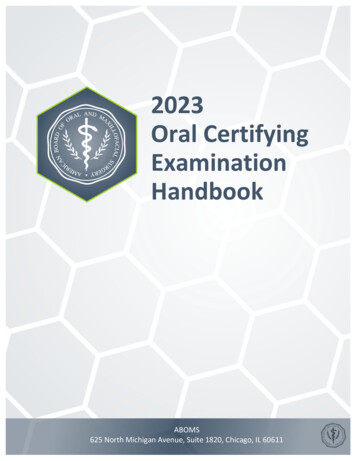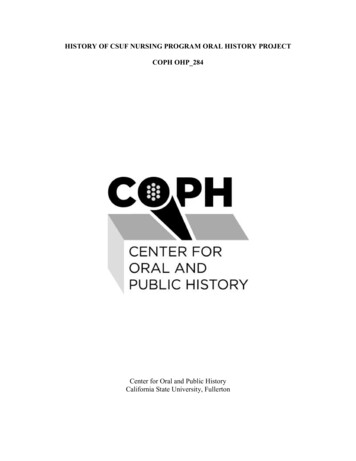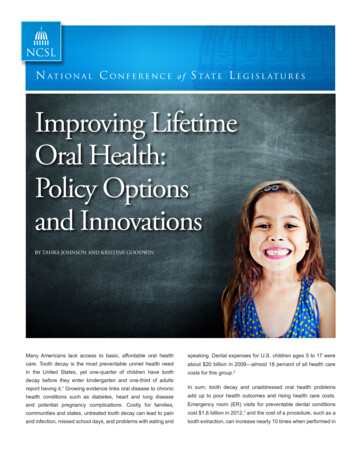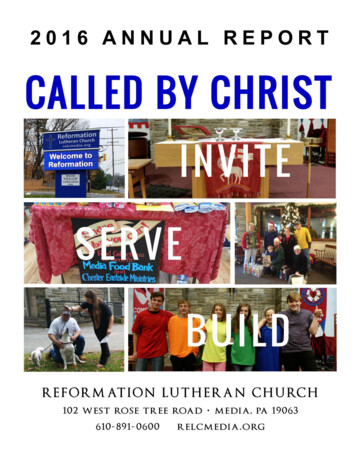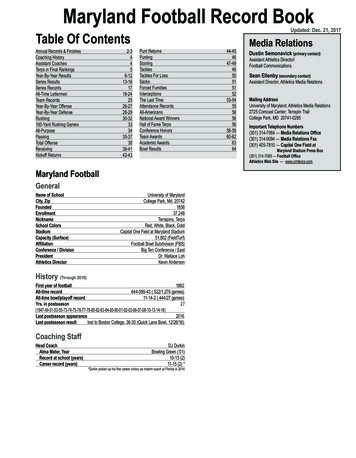
Transcription
MARYLAND’S 2016 ANNUAL ORAL HEALTH LEGISLATIVE REPORTHealth-General Article, §13-2504(b)Larry HoganGovernorBoyd K. RutherfordLt. GovernorDennis R. SchraderSecretary, DHMH
Table of ContentsExecutive Summary1I. Introduction6II. Maryland’s Oral Health Accomplishments7Part 1. Oral Health Safety Net Program7Background7Oral Health Screening Surveys7Major Oral Health Recommendations8Expanding Oral Health Infrastructure13Part 2. Oral Cancer Initiative17Background17Other Activities17Part 3. Medicaid Dental Care Access19Background19Availability and Accessibility of Dentists in Medicaid19Maryland Healthy Smiles Dental Program Dental Utilization Rates22HealthChoice Dental Utilization Rates28Addressing Dental Health Professional Shortage Areas30Strategies to Improve Access to Dental Care31Funding31III. Conclusions and Future Initiatives34IV. Appendices36Appendix A: Glossary of Key Abbreviations36Appendix B: Medicaid Dental Funding, Expenditures, and Utilization RatesSFY 1997 – CY 201537Appendix C: State Public Health Dental Programs38Appendix D: Map of Maryland Health Professional Shortage Areas40Appendix E: Medicaid Dental Utilization Rates, CY 2004 – CY 2015 (Enrollment inMedicaid 320 Days*, Ages 4-20)41
Executive SummaryMaryland is recognized as a national leader in oral health. This recognition is a directresult of the State’s progress in implementing comprehensive recommendations from theMaryland Dental Action Coalition (MDAC), formerly known as the 2007 Dental ActionCommittee (DAC) 1, for improving access to oral health services through changes to theMaryland Medical Assistance Program (Medicaid) and expansion of the public health dentalinfrastructure. Since 2010, the Pew Center on the States (Pew Center) has given Maryland highgrades in its annual oral health report card for states for its efforts to improve dental care accessfor low-income Marylanders, especially those who are Medicaid-eligible or uninsured. As theonly state to meet seven of the eight dental access policy benchmarks, the Pew Center rankedMaryland first in the nation for children’s oral health in 2011. 2 When the Pew Center revised itsreport card parameters and performance measures in 2012 to emphasize prevention, Maryland’s“B” grade made the state one of only thirteen to receive a grade higher than a “C.” 3 The PewCenter published its latest report card in April 2015. 4 In the report, Maryland retained a “B”grade for its continued efforts to ensure access to preventive dental care for 2014. 5In September 2015, the American Dental Association’s Health Policy Institute released aresearch brief analyzing Medicaid and private dental utilization across 46 states and the Districtof Columbia. 6 The Health Policy Institute found that from 2005 to 2013, the dental utilizationgap between privately insured children and those enrolled in Medicaid narrowed, on average, by53 percent. In Maryland, the children’s dental utilization gap narrowed by over 80 percent; theseventh largest decrease reported.In April 2010, the Centers for Medicare and Medicaid Services (CMS) launched itsnational Oral Health Initiative and asked states to participate by increasing the use of preventivedental services by children enrolled in Medicaid by at least 10 percentage points in five years.The national goal is for at least 52 percent of Medicaid enrolled children aged 1-20 years to1The Dental Action Committee has since reorganized into an independent coalition and is now called the MarylandDental Action Coalition.2The Pew Center on the States, “The State of Children’s Dental Health: Making Coverage Matter,” May 2011, ThePew Charitable Trust, 1 October 2015 http://www.pewtrusts.org/ s/state policy/childrensdental50statereport2011pdf.pdf .3The Pew Center on the States, “Falling Short: Most States Lag on Dental Sealants,” 8 January 2013, The PewCharitable Trust, 1 October 2015 n-dentalsealants .4The Pew Center on the States, “States Stalled on Dental Sealants”, 23 April 2015, The Pew Charitable Trust, 12October 2016 http://www.pewtrusts.org/ 2015/pew dental sealants maryland.pdf?la en .5Id fn 46American Dental Association Health Policy Institute, “Gap in Dental Care Utilization Between Medicaid andPrivately Insured Children Narrows, Remains Large for Adults,” 29 September 2015, The American DentalAssociation, 12 October 2016 http://www.ada.org/ rief 0915 1.ashx .
2016 Annual Oral Health Legislative ReportPage 2receive a preventive dental service by federal fiscal year (FFY) 2015. The interim goal for eachstate is to improve by two percentage points each year. Maryland was one of 15 states to meetthe first-year CMS Oral Health Initiative goal. 7 For calendar year (CY) 2015, Marylandremained above the target federal goal at 52.8 percent (see Table 5).To sustain and improve upon the State’s delivery of care, the Department of Health andMental Hygiene (the Department) recognizes that a more holistic approach is necessary toidentify gaps and further reduce inequities in the availability and quality of dental care inMaryland. Provider access remains an issue in some areas of the State. Ensuring children acrossthe State have access to preventive services, like fluoride varnishes, is an ongoing challenge.Additionally, adequate oral health care is important for older adults as well as other age groups.Oral Health America recently released a report highlighting that oral health problems are morefrequently found in older adult populations for whom other health problems are often a priority.A large number of older adults lack dental insurance, and many have no plan in place to pay fordental care once they retire. In addition, older adults may be unaware that Medicare does notcover dental services. 8 Consequently, dental care is unreachable for many older individualsliving on a fixed income.Oral Health Safety Net ProgramThe Governor included 1.5 million in the state fiscal year (SFY) 2016 budget for theDepartment’s Office of Oral Health (OOH), to continue to support community-based oral healthgrants. These grants aim to expand the dental public health capacity for low-income, disabled,and Medicaid-eligible populations. Building on prior successes, this additional funding providesMarylanders in every county access to a public health dental clinic that is either located within orserves their jurisdiction.Through two cooperative agreements with the Centers for Disease Control andPrevention (CDC), OOH developed a statewide Oral Health Literacy Campaign, entitled“Healthy Teeth, Healthy Kids,” and a school-based dental sealant demonstration project that wasimplemented in ten elementary schools. In 2010, OOH leveraged this demonstration project tocreate a statewide school-based and school-linked dental sealant program. The Maryland MightyTooth Dental Sealant Program funded school-based and school-linked sealant programs in 11counties during the 2015-2016 school year. A statewide meeting of dental sealant programcoordinators was held to examine the components of the funded programs, provide networkingopportunities for program professionals, and discuss methods for overcoming systematicchallenges through identification of best practices. The Mighty Tooth Dental Sealant Programhas grown from five counties in SFY 2009 to 11 counties with programs in SFY 2016.7Centers for Medicare and Medicaid Services, “CMCS Informational Bulletin: Update on CMS Oral HealthInitiative and Other Oral Health Related Items,” 10 July 2014, Department of Health and Human Services,1 October 2015 wnloads/CIB-07-10-2014.pdf .8Oral Health America, “A State of Decay Vol. III, 2016,” Tooth Wisdom, 13 October 2016 http://www.toothwisdom.org/pages/a-state-of-decay .
2016 Annual Oral Health Legislative ReportPage 3Additionally, in January 2016, five new dentists began their 3-year commitment to theMaryland Dent-Care Loan Assistance Repayment Program (MDC-LARP). These dentists willwork with the program through December 2018. During CY 2015, MDC-LARP dentists treated18,894 unduplicated Medicaid patients, and billed 47,234 dental visits for Medicaid patients.At the local level, the Kaiser Foundation awarded a 200,000 grant to MDAC inpartnership with OOH in 2011 to fund a pilot dental screening program linking to an establishedschool-based dental clinic in Prince George’s County. The program began operations in October2011. During school year 2015-2016, in Prince George’s County, the Deamonte Driver MobileDental Van Project (DDDVP) provided diagnostic and preventive services for 1,516 PrinceGeorge’s County children, of which 739 received clinic referrals for immediate restorative orurgent care.To provide additional support for the dental public health infrastructure in Maryland, theMaryland Community Health Resources Commission (MCHRC) continues its commitment toexpanding and creating new capacity for dental care to serve low-income, underinsured, anduninsured populations. Since March 2008, the MCHRC has awarded 31 dental grants totaling 6.3 million, which have collectively served more than 48,000 low-income children and adults,resulting in over 106,000 dental visits.Oral Cancer Prevention InitiativeThe Oral Cancer Prevention Initiative (the Initiative), mandated by Chapter 307 of theActs of 2000 (SB 791), requires that the Department implement programs to train health careproviders on oral cancer screening and referral of patients with oral cancer to appropriate serviceproviders, and to provide education on oral cancer prevention for high-risk, underservedpopulations. As of June 30, 2016 (SFY 2016), 8,268 individuals were screened for oral cancer,29,897 individuals provided oral cancer education, and 320 health care providers received oralcancer education through the Initiative.OOH participates in awareness-building activities and, in the last year, took part inseveral Maryland Oral Cancer Awareness Month activities, sponsored the eighth AnnualBaltimore Oral Cancer Walk/Run for Awareness, and collaborated with the Maryland TobaccoQuitline to support the link between cessation programs and reducing the risk of oral cancer.Medicaid Dental Care AccessGuided by the DAC’s recommended strategies in 2007, the Medicaid programimplemented major programmatic changes that have contributed to a significant increase indental utilization among Medicaid enrollees. Maryland continues to improve its dental programby confronting barriers to providing comprehensive oral health services to Medicaid enrollees,such as low provider participation. Low provider participation is the result of multiple factorsincluding, but not limited to, low reimbursement rates, missed appointments, and low enrolleeutilization due to a lack of awareness about the benefits of basic oral health care.
2016 Annual Oral Health Legislative ReportPage 4The DAC recommended that Medicaid initiate a single statewide dental administrativeservices organization (ASO) for the Maryland Healthy Smiles Dental Program, Medicaid’sdental benefit. Medicaid adopted this model and procured its first ASO in July 2009. The ASOis responsible for coordinating all dental services for children, pregnant women, and adults in theRare and Expensive Case Management Program. Additionally, the ASO is responsible for allfunctions related to the delivery of dental services, including provider network development andmaintenance, claims processing, utilization review, authorization of services, outreach andeducation, and complaint resolution. DentaQuest (formerly Doral Dental) served as Medicaid’sASO from July 2009 through 2015. As a result of Medicaid’s procurement, Scion Dental(Scion) became the new ASO, effective January 1, 2016.Scion provides dental benefit administration services to more than 9 million Medicaidparticipants nationwide. Scion’s systems were built specifically for dental programs, and thecompany only services Medicaid programs. Scion brings significant technical innovations to theadministration of the Maryland Healthy Smiles Dental Program, which will streamline providerengagement and bolster the Department’s data analytics capabilities. Scion’s transition has beensuccessful, with minimal disruption for participants and providers.Medicaid spent 165.2 million for dental expenditures in CY 2015, nearly 109.8 millionmore than in CY 2008 (see Appendix B). Utilization rates have increased and provider networkshave expanded since Medicaid rebranded its dental benefit as the Maryland Healthy SmilesDental Program. Specifically: More than 1,400 dentists (1,472) dentists are enrolled with the Maryland HealthySmiles Dental Program as of August 2016, an increase from 649 in August 2009. In 2015, 457,143 children and adults (ages 0-64) enrolled in Medicaid received dentalcare. In 2015, 69 percent of children (ages 4-20) enrolled in Medicaid for at least 320 daysreceived dental care, which is considerably higher than the national mean for AnnualDental Visits using the National Committee for Quality Assurance HealthcareEffectiveness Data and Information Set (HEDIS ). 9 CMS published data that offers a comparison between Maryland dental utilization andthe national average. The Annual Early and Periodic Screening, Diagnosis, andTreatment (EPSDT) Program Report for FFY 2014 and FFY 2015 demonstrates thatMaryland dental utilization for children ages 0-20 is 54.5 and 52.9 percentrespectively. This continues to outpace the national average, at 43.3 and 44.8 percent,over that same time. For each of the last seven years, less than one percent of children enrolled in Medicaidsought treatment for a dental diagnosis in the emergency room.9Due to National Committee for Quality Assurance licensing restrictions, beginning with CY 2013, the NationalHEDIS Mean can no longer be published in this report.
2016 Annual Oral Health Legislative ReportPage 5 In 2015, 27.3 percent of pregnant women (14 years and over) enrolled for any periodreceived a dental service.In December 2013, the Dental Home Program was implemented statewide in Maryland.Maryland Healthy Smiles Dental Program participants enrolled in the Dental Home Program arechildren under the age of 21 and Rare and Expensive Case Management Program recipients overthe age of 21. In the SFY 2015 budget, Medicaid received almost 1.1 million in general fundsto increase dental reimbursement rates beginning in January 2015.As of August 2016, approximately 1,381 dentists had received training in pediatricdentistry through various state-sponsored courses since 2009. In July 2009, the Departmentbegan training and reimbursing Medicaid primary care providers for the application of fluoridevarnish for children up to three years of age. By June 2016, 461 unique EPSDT certifiedproviders had administered over 172,037 fluoride varnish treatments to Medicaid children.The Department greatly appreciates the strong commitment demonstrated by theGovernor and General Assembly to transforming Maryland’s capacity to provide oral healthservices. With ongoing funding and support, the Department and its many dedicated partnerswill continue working together to address the oral health needs of all Marylanders, with a specialemphasis on vulnerable populations.
2016 Annual Oral Health Legislative ReportPage 6I. IntroductionPursuant to Health-General Article §13-2504(b), Annotated Code of Maryland, theMaryland Medical Assistance Program (Medicaid) and the Office of Oral Health (OOH) withinthe Department are required to submit a comprehensive oral health report that addresses thefollowing areas:(1) The results of the Oral Health Safety Net Program administered by OOH;(2) Findings and recommendations for the Oral Health Safety Net Program and OOH’s OralCancer Initiative;(3) The availability and accessibility of dentists throughout the State participating inMedicaid;(4) The outcomes that managed care organizations (MCOs) and dental MCOs underMedicaid achieve concerning the utilization of targets required by the Five Year OralHealth Care Plan, 10 including:(a) Loss ratios that the MCOs and dental MCOs experience for providing dentalservices; and(b) Corrective action by MCOs and dental MCOs to achieve the utilization targets;and(5) The allocation and use of funds authorized for dental services under Medicaid.Part 1 of this report details the Oral Health Safety Net Program administered by theDepartment’s OOH, including collaboration between the Department and other stakeholders tostrengthen access to comprehensive dental care for low-income, disabled, and Medicaidpopulations through clinical dental programs, school-based oral health services, and otherinitiatives throughout the State. This section also provides an update on the Department’s mostrecent follow-up survey concerning the oral health status of school children in the State.Part 2 focuses on progress made by OOH’s Oral Cancer Mortality Prevention Initiative.This section documents the initiatives implemented to increase public and professionalawareness of the importance of oral cancer screening, the impact of outreach combined withbroadening training efforts for dentists to conduct oral cancer screenings, and progress indetecting and treating oral cancer in Maryland residents since the initiative began in 2000.10The Five Year Oral Health Plan was established by Chapter 113 of the Acts of 1998 (Senate Bill 590) and at thetime established five consecutive years of dental access targets starting in 1998 when dental access was expected toincrease by 10 percent each year. This iteration of the Plan concluded in 2003 and information related to the targetsset by the 1998 Plan will not be included in this report.
2016 Annual Oral Health Legislative ReportPage 7Part 3 addresses the availability of dentists participating in the Maryland Healthy SmilesDental Program, Medicaid’s dental services program; access to care for Medicaid populationsunder the administrative services organization (ASO) (or dental benefit administrator); andservices offered by local health departments to low-income residents in dental HealthProfessional Shortage Areas (HPSAs). This section also details funding for dental services underthe Medicaid Program.II. Maryland’s Oral Health AccomplishmentsPart 1. Oral Health Safety Net ProgramBackgroundImproving access to oral health services is both serious and complex in scope, requiringmultiple strategies. Chapters 527 and 528 of the Acts of 2007 (HB 30/SB 181) established theOral Health Safety Net Program within OOH. The purpose of the program is to (1) supportcollaborative and innovative ways to expand oral health capacity for low-income, disabled, andMedicaid populations by awarding community-based oral health grants to local healthdepartments, federally qualified health centers (FQHCs), and other non-profit entities providingdental services within state facilities; (2) contract with a licensed dentist to provide public healthexpertise for the State; and (3) provide continuing education courses to providers that offer oralhealth treatment to underserved populations.OOH has employed a licensed public health dentist since the creation of the Oral HealthSafety Net Program. The public health dentist is the expert voice of OOH, representing theDepartment with internal and external stakeholders including legislators, local healthdepartments, professional societies, dental and public health schools, along with other federalHealth and Human Services divisions. The public health dentist provides dental expertise onpolicy development, legislation, surveillance, protocol evaluation, provider recruitment, andcontinuing education courses for providers that offer oral health treatment to underservedpopulations. OOH continues to explore new and creative strategies to enhance the oral healthsafety net and improve access to oral health services for low-income and uninsured individuals,and Medicaid recipients. These strategies include: providing new or expanded dental services inpublicly funded federal, state, or local programs; developing public and private partnerships;expanding school-based and school-linked dental initiatives that include mobile dental vans,transportation innovations, case management, leasing and contractual agreements with privatedental offices; and other strategies.Oral Health Screening SurveysOOH conducts an oral health survey of Maryland school children every five years. The2015-16 survey is currently underway. Additionally, in 2013, OOH conducted a survey of theoral health status of older adults in Maryland. Both surveys provide a picture of the oral healthneeds of two vulnerable populations in Maryland.Oral Health Survey of Maryland School Children
2016 Annual Oral Health Legislative ReportPage 8OOH partnered with the University of Maryland School of Dentistry to conduct the 2015- 2016 Oral Health Survey of Maryland School Children. Fifty-six elementary schoolsparticipated in the survey and 7,942 students were screened. Data collection began in September2015 and ended in June 2016. The report will be released in the summer of 2017.Major Oral Health RecommendationsOOH collaborates with many partners to carry out the Oral Health Safety Net Program.OOH’s partners include the Maryland Dental Action Coalition (MDAC), whose mission is toimprove the oral health of all Marylanders. Since its inception, MDAC has recommendedseveral changes to the Medicaid program to improve access to comprehensive dental servicesamong eligible children. MDAC has also provided suggestions to enhance education, outreach,dental public health infrastructure, provider participation, and provider scope of practice.Maintaining and Enhancing the Dental Public Health InfrastructureThe Governor’s state fiscal year (SFY) 2016 budget for OOH included 1.5 million tosustain clinical dental treatment and preventive services for low-income Maryland children,especially those who are Medicaid-eligible or uninsured, and to support many of therequirements listed in the 2007 Oral Health Safety Net legislation. While these Oral HealthSafety Net grant funds are used statewide, the grants are targeted to Calvert, Kent, QueenAnne’s, and Worcester counties—jurisdictions previously identified as not being served by aclinical public health dental program. Calvert County: Funding provided to Calvert County supports a variety of dental publichealth initiatives. Since its inception in September 2009, Calvert Memorial Hospital’sCalvert Community Dental Care program has provided direct services to low-incomechildren and adults, including Medicaid recipients, in Calvert and St. Mary’s Counties. Itis one of very few public dental programs in the State that provides services to the adultMedicaid population. The program had a total of 1,714 encounters in SFY 2015, and1,227 encounters in SFY 2016. The decrease in utilization is primarily due to a cluster offactors related to disengagement from treatment and demographic variables.In August 2014, a pilot program was implemented to establish a direct referral systemfrom the emergency room (ER) to the dental clinic. The pilot was renewed as a fullprogram in January 2016. The program provides a limited exam within 24 to 48 hours ofa visit to the ER for dental care, except on weekends.Calvert County’s school-linked dental services program recently added preventive examsand sealants for children in grades three through five at Appeal Elementary. TheCounty’s long-standing partnership with Head Start and the Judy Center for annualexams, screenings, and sealants for younger children whose permanent molars haveerupted continues. As a result, more children are being seen for dental care at theschools.
2016 Annual Oral Health Legislative ReportPage 9The program continues to partner with the Southern Maryland Mission of Mercy teamand the Tri-County Veterans Council to host a Mission of Mercy event for veterans. Incollaboration with the Calvert County Health Department, the program provides fundingfor emergency dental care for those who cannot afford it but require emergencyintervention due to severe abscess or decay. Kent/Northern Queen Anne’s Counties: The program serving these counties providesdental screening, fluoride varnish, tooth brushing with fluoridated toothpaste, casemanagement and transportation for those with urgent and early dental needs, andeducation. The goal of the program is to increase the portion of low-income childrenwho receive preventive dental services and reduce the proportion of children withuntreated dental decay. Reaching children at a younger age promotes good oral hygieneskills, a positive dental experience, finding a dental home for regular check-ups, andearlier identification and treatment of urgent and early dental needs. The program targetsseven elementary schools (six are Title 1 schools) and 41 community-based organizationsin Kent and Northern Queen Anne's Counties.There is a shortage of dentists in both Kent and Queen Anne’s Counties, which impactsaccess to care. According to newly-released 2015 County Health Rankings, Kent'spopulation to dentist ratio is 2,849:1 and Queen Anne's ratio is 2,695:1. Statewide,Maryland's population to dentist ratio is 1,392:1. Only one dentist in Kent Countyprovides preventive care to children enrolled in Medicaid, and no dentists providerestorative care. In addition, only two of the seven Kent County towns onmunicipal/county water systems, have fluoridated water; a contributing factor to the oralhealth challenges in this region. Twenty-five percent of homes in Kent County have wellwater with no fluoride. Community awareness and education is supported through familydaycare, childcare centers, pre-kindergarten registration, migrant camps, participation insports, and other child oriented events. Other partners include state agencies, publichealth organizations, local agencies, and health care providers. Worcester County: The Worcester County Health Department partners with WorcesterCounty Schools and the Three Lower Counties FQHC to expand school-based dentaleducation and screening services and to receive referrals for children needing a dentalhome. Dental care is integrated into the Worcester County Health DepartmentBehavioral Health summer camp for children ages 5-18, which allows for onsitescreenings while clients are receiving behavioral health intervention. In SFY 2016, thehealth department implemented a school-linked program to identify middle schoolchildren in need of dental care and to provide dental sealants and any other necessarytreatment. OOH intends to maintain funding for this program until it is self-sustainingthrough the receipt of sufficient Medicaid and other insurance revenues.In SFY 2016, OOH statewide grants contributed to 28,120 children and 13,401 adultsreceiving care through local health department dental programs, and 44,155 child and 23,806adult clinical visits. Further, 3,818 adults received emergency treatment in local healthdepartment programs because of these grants. Geographic areas with high-need for dental publichealth services on Maryland’s Eastern Shore and in Southern Maryland have benefitted greatly
2016 Annual Oral Health Legislative ReportPage 10from these grant programs (see Appendix C for a full listing of state public health dentalprograms).Developing a Unified, Culturally and Linguistically Appropriate Oral Health MessageMighty Tooth Social Marketing CampaignIn SFY 2016, OOH conducted a social marketing outreach campaign called the “MightyTooth” to increase awareness of the importance of dental sealants. The campaign reached out toMaryland parents, educating them about the importance of dental sealants and making themaware of resources available to help them prevent cavities in their children. The campaignspecifically targeted women with school age children (primarily African American) over a sixmonth period from October 2015 – March 2016. The campaign raised awareness about theState’s Mighty Tooth Dental Sealant Program and website (www.mightytooth.com). TheMighty Tooth Dental Sealant campaign utilized a variety of media strategies to communicate itsmessage. In addition to brochure distribution and ongoing OOH educational activities, thecampaign utilized two key media strategies to reach its audience: (1) media news coveragediscussing the importance of dental sealants; and (2) a focused radio advertising campaignemphasizing the importance of dental sealants, and promoting the Mighty Tooth program, anddirecting listeners to the Mighty Tooth website.OOH worked with Profiles, Inc. an established media relations vendor located inBaltimore – to generate TV, radio, print, and online news coverage over a six-month period.Within this timeframe, there were 33 media news stories on dental sealants in theBaltimore/Washington, D.C. metro area with an average of more than one news story per week.The stories generated more than four million viewer impressions and had an estimatedadvertising dollar value of 102,000.In addition to the news coverage, OOH reinforced its dental sealant message with aneight–week radio advertising campaign. The campaign goals were to: (1) create awareness ofthe importance of dental sealants, (2) create awareness of the Mighty Tooth program, directingindividuals to the website (www.mightytooth.com), and (3) encourage parents to talk with theirdentist about dental sealants for their children. The campaign targeted African-American womenin Baltimore City, Baltimore County, Prince George’s County, and the suburban Washington,D.C. area. From February 1 to March 13, 2016, there were 364 thirty-second radioadvertisements that ran on five stations (urban, R&B, gospel, and PBS), advertising on twost
school-based dental clinic in Prince George's County. The program began operations in October 2011. During school year 2015-2016, in Prince George's County, the Deamonte Driver Mobile . DentaQuest (formerly Doral Dental) served as Medicaid's ASO from July 2009 through 2015. As a result of Medicaid's procurement, Scion Dental (Scion .

